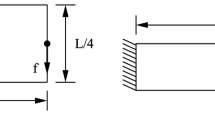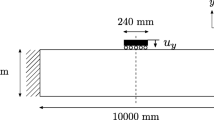Abstract
We present a novel numerical method for calculating optimal design in topology optimization problems for 3D linear elastic structures. The algorithm is based on necessary conditions of optimality for problem which was obtained by relaxing the original one via the homogenization method in the sense of operators (G- or H-convergence), and can be implemented for self-adjoint problems. The method relies on recently obtained explicit expressions for the lower Hashin–Shtrikman bound on complementary energy and information on the microstructure that saturates the bound. We tested the algorithm on two benchmark examples, namely the cantilever and the bridge problem. The algorithm provides the solution in a first few iterations and the true composites appear in the optimal design. We also implement a penalization procedure to obtain classical design with slight increase of the cost functional.








Similar content being viewed by others
References
Akerson A, Bourdin B, Bhattacharya K (2022) Optimal design of responsive structures. Struct Multidiscip Optim 65:111. https://doi.org/10.1007/s00158-022-03200-5
Allaire G (1994) Explicit lamination parameters for three-dimensional shape optimization. Control Cybern 23:309–326
Allaire G (2002) Shape optimization by the homogenization method. Springer, Berlin
Allaire G, Kohn RV (1993) Optimal bounds on the effective behavior of a mixture of two well-ordered elastic materials. Q Appl Math 51(4):643–674
Allaire G, Kohn RV (1993) Explicit optimal bounds on the elastic energy of a two-phase composite in two space dimensions. Q Appl Math 51(4):675–699
Allaire G, Kohn RV (1993) Optimal design for minimum weight and compliance in plane stress using extremal microstructures. Eur J Mech A/Solids 12(6):839–878
Allaire G, Bonnetier E, Francfort G, Jouve F (1997) Shape optimization by the homogenization method. Numer Math 76:27–68
Allaire G, Aubry S, Jouve F (2001) Eigenfrequency optimization in optimal design. Comput Methods Appl Mech Eng 190(28):3565–3579
Allaire G, Geoffroy-Donders P, Pantz O (2019) Topology optimization of modulated and oriented periodic microstructures by the homogenization method. Comput Math Appl 78:2197–2229
Avellaneda M (1987) Optimal bounds and microgeometries for elastic two-phase composites. SIAM J Appl Math 47(6):1216–1228
Bangerth W, Hartmann R, Kanschat G et al (2021) The deal.II library. http://www.dealii.org/
Bendsøe M (1995) Methods for optimization of structural topology, shape and material. Springer, Berlin
Bendsøe M, Diaz A (1994) Optimization of material properties for improved frequency response. Struct Optim 7:138–140
Bendsøe M, Sigmund O (2003) Topology optimization: theory, methods and applications, 2nd edn. Springer, Berlin
Burazin K (2018) On unique solutions of multiple-state optimal design problems on an annulus. J Optim Theory Appl 177:329–344
Burazin K, Crnjac I (2020) Convergence of the optimality criteria method for multiple state optimal design problems. Comput Math Appl 79(5):1382–1392
Burazin K, Vrdoljak M (2019) Exact solutions in optimal design problems for stationary diffusion equation. Acta Appl Math 161(1):71–88
Burazin K, Crnjac I, Vrdoljak M (2018) Variant of optimality criteria method for multiple state optimal design problems. Commun Math Sci 16(6):1597–1614
Burazin K, Crnjac I, Vrdoljak M (2021) Optimality criteria method in 2D linearized elasticity problems. Appl Numer Math 160:192–204
Burazin K, Crnjac I, Vrdoljak M (2023) Explicit Hashin-Shtrikman bounds in 3D linearized elasticity, under review
Casado-Diaz J (2015) Some smoothness results for the optimal design of a two-composite material which minimizes the energy. Calc Var Partial Differ Equ 53:649–673
Casado-Diaz J (2022) The maximization of the first eigenvalue for a two-phase material. Appl Math Optim. https://doi.org/10.1007/s00245-022-09825-8
Casado-Díaz J, Castro C, Luna-Laynez M, Zuazua E (2011) Numerical approximation of a one-dimensional elliptic optimal design problem. Multiscale Model Simul 9:1181–1216
Francfort G, Murat F (1986) Homogenization and optimal bounds in linear elasticity. Arch Rat Mech Anal 94:307–334
Geoffroy-Donders P, Allaire G, Pantz O (2020) 3-d topology optimization of modulated and oriented periodic microstructures by the homogenization method. J Comput Phys 401:108994
Gibianski L, Cherkaev A (1987) Microstructures of composites of extremal rigidity and exact bounds of the associated energy density. Ioffe Physicotechnical Institute preprint
Gibianski L, Cherkaev A (1997) Design of composite plates of extremal rigidity, Ioffe Physicotechnical Institute preprint, 1984 (english translation in: Topics in the mathematical modelling of composite materials, Ser. PNLDE, vol 31, Birkhauser, Basel, 95-137)
Groen JP, Sigmund O (2018) Homogenization based topology optimization for high resolution manufacturable microstructures. Int J Numer Methods Eng 113:1148–1163
Hashin Z, Shtrikman S (1962) A variational approach to the theory of the effective magnetic permeability of multiphase materials. J Appl Phys 33:3125–3131
Hashin Z, Shtrikman S (1963) A variational approach to the theory of the elastic behaviour of multiphase materials. J Mech Phys Solids 11(2):127–140
Kohn RV, Lipton R (1988) Optimal bounds for the effective energy of a mixture of isotropic, incompressible, elastic materials. Arch Rat Mech Anal 102:331–350
Kohn R, Strang G (1986) Optimal design and relaxation of variational problems I–III. Commun Pure Appl Math 39:113–137, 139–182, 353–377
Lurie K (1970) On the optimal distribution of the resistivity tensor of the working substance in a magnetohydrodynamic channel. J Appl Math Mech (Prikladnaya Matematika i Mekhanika) 34(2):255–274 (in Russian)
Lurie K, Cherkaev A (1984) Exact estimates of conductivity of composites formed by two isotropically conducting media, taken in prescribed proportion. Proc R Soc Edinb 99A:71–87
Lurie K, Cherkaev A (1986) Effective characteristics of composite materials and the optimal design of structural elements. Uspekhi Mekhaniki 9:3–81
Lurie K, Cherkaev A, Fedorov A (1982) Regularization of optimal design problems for bars and plates I–II. J Optim Theory Appl 37:499–543
Milton GW (1990) On characterizing the set of possible effective tensors of composites: the variational method and the translation method. Commun Pure Appl Math 43(1):63–125
Milton GW (2002) The theory of composites. Cambridge University Press, Cambridge
Milton GW, Kohn RV (1988) Variational bounds on the effective moduli of anisotropic composites. J Mech Phys Solids 36:597–629
Murat F, Tartar L (1985) Optimality conditions and homogenization. In: Marino A et al (eds) Nonlinear variational problems. Pitman, Boston, pp 1–8
Murat F, Tartar L (1978) H-convergence. In: Séminaire d’Analyse Fonctionnelle et Numérique de l’Université d’Alger. Lecture Notes
Querin O, Victoria M, Alonso C, Loyola R, Montrull P (2017) Topology design methods for structural optimization. Elsevier, Amsterdam
Raitums U (1978) The extension of extremal problems connected with a linear elliptic equation. Sov Math 19:1342–1345
Rozvany G (1989) Structural design and optimality criteria. kluwer Academic Publishers, Alphen aan den Rijn
Save M, Prager W (1985) Structural optimization, volume 1 optimality criteria. In Warner W (ed). Plenum Press, New York
Tartar L (1975) Problèmes de contrôle des coefficients dans des équations aux dérivées partielles. In: Bensoussan A, Lions J-L (eds) Control theory, numerical methods and computer systems modelling, international symposium, Rocquencourt, June 1974. Lecture notes in economy and mathematical systems, vol 107. Springer, Berlin, pp 420–426
Tartar L (1985) Estimations fines des coefficients homogénéisés, Ennio DeGiorgi colloquium (Paris, 1983). In: Krée P (ed) Research notes in mathematics, vol 125. Pitman, London, pp 168–187
Tartar L (1986) Homogenization and effective moduli of materials and media. In: Ericsen JL et al (eds) Remarks on homogenization. Springer, Berlin, pp 228–246
Vrdoljak M (2010) On Hashin–Shtrikman bounds for mixtures of two isotropic materials. Nonlinear Anal Real World Appl 11:4597–4606
Vrdoljak M (2016) Classical optimal design in two-phase conductivity problems. SIAM J Control Optim 54(4):2020–2035
Zhikov V, Kozlov S, Oleinik O (1994) Homogenization of differential operators and integral functionals. Springer, Berlin
Acknowledgements
We would like to thank to Prof. Domagoj Matijević (School of Applied Mathematics and Computer Science, J. J. Strossmayer University of Osijek) who provided us with technical support for execution of parts of the algorithm.
Funding
This work has been supported in part by Croatian Science Foundation under the projects 8904 Homdirestroptcm.
Author information
Authors and Affiliations
Corresponding author
Ethics declarations
Conflict of interest
The authors declare that they have no known competing financial interests or personal relationships that could have appeared to influence the work reported in this paper.
Additional information
Publisher's Note
Springer Nature remains neutral with regard to jurisdictional claims in published maps and institutional affiliations.
Rights and permissions
Springer Nature or its licensor (e.g. a society or other partner) holds exclusive rights to this article under a publishing agreement with the author(s) or other rightsholder(s); author self-archiving of the accepted manuscript version of this article is solely governed by the terms of such publishing agreement and applicable law.
About this article
Cite this article
Burazin, K., Crnjac, I. Application of explicit energy bounds in optimization of 3D elastic structures. Optim Eng (2023). https://doi.org/10.1007/s11081-023-09840-w
Received:
Revised:
Accepted:
Published:
DOI: https://doi.org/10.1007/s11081-023-09840-w




